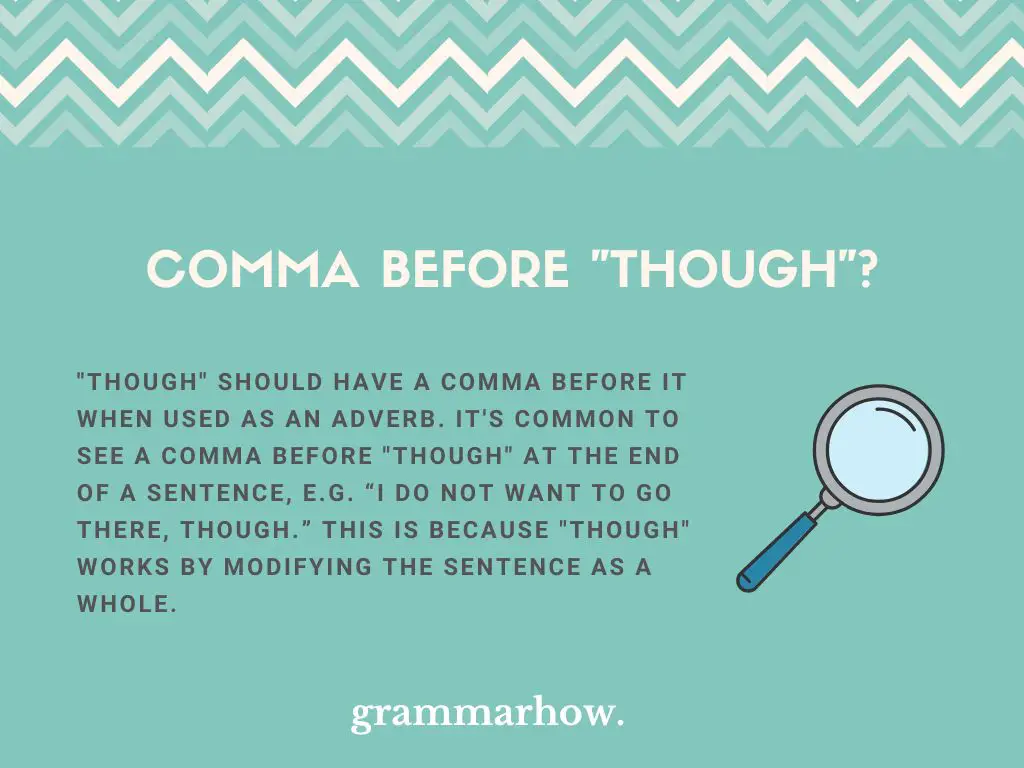Commas are used to break up the flow of a spoken sentence or include parenthetical elements as extra details. This article will look at when it’s appropriate to place a comma before “though.” There are a few reasons why you might do this.
Comma Before “Though”?
“Though” should have a comma before it when used as an adverb. It’s common to see a comma before “though” at the end of a sentence, e.g. “I do not want to go there, though.” This is because “though” works by modifying the sentence as a whole.

Common stylebooks like The AP Stylebook and the Chicago Manual of Style agree that a comma can come before “though” when used as an adverb. You might see it like this:
- I do not want to go there, though.
Here, “though” modifies “go” and the sentence as a whole. The comma acts as a brief pause between “there” and “though.” If you were to say this sentence aloud, you would find yourself pausing (however briefly) before saying “though.”
APA Style also corroborates these rules. “Though” should always have a comma before it when included at the end of a sentence. Removing the comma is an informal way of removing the brief pause in the sentence.
When to Place a Comma Before “Though”
Let’s talk about commas before “though” a little more. Before continuing, we need to ensure we understand everything there is to know about this.
A comma should always come before “though” when it falls at the end of a sentence. It’s used as an adverb in this form.
Here are some examples showing you how to use “though” as an adverb:
- I wasn’t going to help her, though.
- She told me all about it, though.
- I was the only person there, though.
- We’re going to be with him, though.
“Though” modifies the sentence, and it’s common for native speakers to pause briefly before “though.” If “though” comes at the end of your sentence, it likely requires a comma.
The other time you might need a comma before “though” is if “though” starts a parenthetical element or as a conjunctive adverb. This isn’t as common, but it works like this:
- Charlotte wanted to help, though she wasn’t sure about it.
- Michael, though short, managed to reach it before anyone else.
When to Use “Though” Without a Comma
“Though” doesn’t always require punctuation. You’ll find there are plenty of situations where the comma isn’t required at all.
You should include a comma with “though” when used as a subordinating conjunction or as an adverb to modify a modal verb.
To start with, let’s look at “though” as a subordinating conjunction to show you how it applies:
- I did not believe in them though I really wish I could.
- She couldn’t stop herself though they told her she was wrong.
- I needed to talk to them though it wasn’t going to be much good.
Here, “though” joins the two clauses with each other. No comma is required to include “though” in the middle of a sentence like this.
It may also modify a modal verb, which means the following examples are correct:
- Shy though he may be, I think he was the one that said those things.
- Confident though he was, he still managed to fall at the final hurdle.
This time, “though” modifies the verbs that come directly after it. Since “though” doesn’t come after the verbs, you do not need to include any commas beforehand.
Comma After “Though”?
It’s possible to find commas after “though.” There’s one final place you can put “though,” which means a comma should come after it.
A comma comes after “though” when you start a sentence with it as an adverbial introduction. This means that “though” modifies the entire sentence rather than a specific verb within the sentence.
It’s most common to see “though” like this when it relates to a previous sentence. “Though” works similarly to “however” or “despite,” showing that the previous statement didn’t affect the outcome that comes next.
Here are some examples showing you how to use a comma after “though:”
- Though, upon reviewing the issues, I think we’ll be able to find a better way to get this done.
- I’m not sure about this. Though, I often doubt myself until I’m presented with the solution.
- She could have been there. Though, I don’t know if she was willing to commit that much time to you.
What to Remember
At the end of the sentence, “though” should have a comma before it.
When in the middle of a sentence, “though” generally modifies a modal verb, meaning no comma is needed.
At the beginning of a sentence, you should always put a comma after “though.”

Martin holds a Master’s degree in Finance and International Business. He has six years of experience in professional communication with clients, executives, and colleagues. Furthermore, he has teaching experience from Aarhus University. Martin has been featured as an expert in communication and teaching on Forbes and Shopify. Read more about Martin here.
